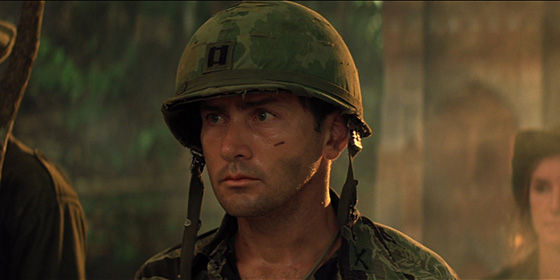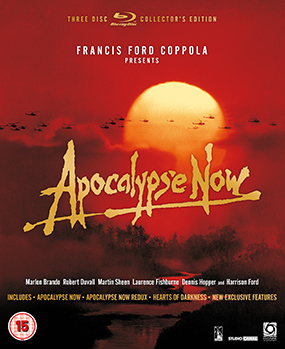
One of the greatest films of the 1970s gets a worthy Blu-ray release which ranks amongst the finest ever in the format.
The reputation of Francis Ford Coppola’s Vietnam War drama has enhanced considerably since its release in 1979 and it looks stunning in this restored version, which includes the original cut, the 2001 redux version and Hearts of Darkness, the 1991 documentary about the making of the film.
Part of the joy of seeing Apocalypse Now in high-definition is that the original film set new standards for visual and audio presentation, whilst at the same time remaining a relevant story about the corrosive horrors of war.
It really is a case of new technology reminding you of the brilliance of a timeless classic.
The pristine high-definition transfer was personally overseen by Coppola and it isn’t an exaggeration to say that it almost looks like a contemporary release.
Presented at long last in the film’s original aspect ratio of 2.35:1, the 1080p image is stunning and the details and colours look sublime.
 Long-time fans of the film will geek out at so many of the memorable set-pieces such as the opening, the helicopter attack set to Wagner and the climax but a younger generation of viewers used to CGI-fuelled epics might also find the film a revelation.
Long-time fans of the film will geek out at so many of the memorable set-pieces such as the opening, the helicopter attack set to Wagner and the climax but a younger generation of viewers used to CGI-fuelled epics might also find the film a revelation.
The film is rightly famous for its pioneering approach to audio and the DTS-HD Master Audio 5.1 track is simply on another level.
Coppola and Walter Murch essentially pioneered what would become known as 5.1 sound with Apocalypse Now and the use of sound in the film is astonishing.
The masterful blend of helicopter rotors with hotel fans in the opening sequence and the innovative synthesised score by Carmine Coppola are just some of the aural elements that are presented on the lossless audio track with sparkling fidelity.
Aside from the quality of the film and its HD presentation, this 3-disc package comes with an abundance of extras, which break down as follows.
DISC ONE
Two versions of the film are included on disc one: the original 1979 theatrical cut (2h 27m) and Apocalypse Now Redux (3h 16m).
Although the Redux cut is interesting I much prefer the original theatrical cut, which has more punch and narrative drive.
My advice is to watch the original version before viewing the Redux edition, as it does contain some interesting scenes, notably a lengthy sequence on a plantation and a different introduction to Col. Kilgore (Robert Duvall).
Coppola recorded a separate commentary for each edition and they are worth listening to as he describes his reasons for excluding the scenes which were later inserted into the Redux edition.
DISC TWO
Most of the extras are found on this and although some of it has appeared on previous DVD editions, Coppola has recorded three special interviews especially for this release.
- A Conversation with Martin Sheen (59:26): This fascinating chat between the director and his leading man sees them discuss the casting process (Harvey Keitel was the original choice for Willard), the arduous shoot (Sheen had a heart attack during filming) and various anecdotes from the set. Both seem to have a genuine affection and respect for one another and for fans of the film it is a rich conversation and an essential watch.
- An Interview with John Milius (49:45): As Coppola freely acknowledges during this interview, screenwriter John Milius was the man behind many of the central ideas and scenes in the film. The title, the notion of basing it on Hearts of Darkness and the helicopter sequence set to Wagner were all his ideas, even though the film evolved during filming. Perhaps most fascinating are the early, experimental roots of the project, which was to shoot it in Vietnam with George Lucas shooting it in black and white (during the actual war!). By the way, fans of The Big Lebowski might like to note that the character of Walter Sobchack (played by John Goodman) is inspired by Milius.
- Fred Roos: Casting Apocalypse (11:44): One of the most interesting aspects of Apocalypse Now is the casting process, some of which we actually see courtesy of various sessions which were filmed. In this interview casting director Fred Roos talks about the hundreds of actors who tested for different parts.
- Mercury Theater Production of ‘Heart of Darkness’ (36:34): A neat inclusion is the audio of the Mercury Theatre’s radio production of Conrad’s novella, which features Orson Welles and his regular acting troupe just a week after infamous ‘War of the Worlds’ broadcast.
- The Hollow Man (16:57): An impressionistic featurette with scenes from the film and production set against Brando reciting T.S. Eliot’s poem.
- Monkey Sampan Deleted Scene (3:03): A deleted scene which fans of The Doors might appreciate as it sees natives singing ‘Light My Fire’ (Jim Morrison went to film school with Coppola)
- Additional Scenes (26:28): There are around 12 deleted scenes included here (some are time coded), of which perhaps the most interesting is the one involving Scott Glenn appearing at Kurtz’s compound.
- Destruction of the Kurtz Compound (6:06): The precise ending of the film has been the subject of much debate as it has changed throughout the years. Although the proper ending is presented on this version of the film, Coppola explains why a final credits sequence was used for various theatrical and TV showings of the film and how it got misinterpreted over time.
- The Birth of 5.1 Sound (5:54): An short but highly illuminating featurette in which Ioan Allen of Dolby explains why Apocalypse Now brought about a revolution in cinema sound and indirectly led to the birth of the now standard 5.1 sound.
- Ghost Helicopter Flyover (3:55): Keeping on the sound elements of the film this explores the surround sound design for a particular sequence.
- The Synthesizer Soundtrack (Text): A reprint from Keyboard magazine which examined the then innovative use of synths on the soundtrack.
- A Million Feet of Film: The Editing of ‘Apocalypse Now’ (17:57): A lot of the production of Apocalypse Now was filmed for posterity and this look at editor Walter Murch working on the film is fascinating.
- Heard Any Good Movies Lately? The Sound Design of ‘Apocalypse Now’ (15:22): Another fascinating glimpse in to the sound design of the film that uses footage from the Zoetrope archives, showing how films were constructed in the pre-digital era.
- The Final Mix (3:09): The studio setup used to achieve the final mix looks like something out of an old sci-fi film but this featurette shows how the amazing final mix was achieved in an analogue world.
- ‘Apocalypse’ Then and Now (3:44): Brief discussion of the differences between both versions of the film.
- 2001 Cannes Film Festival: Francis Ford Coppola (38:35): Lengthy interview at the American Pavilion during Cannes 2001 (as the Redux version was premiered) between Roger Ebert and Coppola as they discuss various aspects of the film, including the original Cannes premiere in 1979.
- PBR Streetgang (4:09): Profiles from 2001 where the actors playing Willard’s crew – including Laurence Fishburne and Timothy Bottoms – talk about their experiences on the film.
- The Color Palette of ‘Apocalypse Now’ (4:06): Another 2001 supplement which discusses how the visuals were restored for the Redux version using the three strip dye transfer Technicolor process.
DISC THREE
- Hearts of Darkness: A Filmmaker’s Apocalypse (1h 36m): The real highlight of the supplements is this extraordinary 1991 documentary that details the long and painful production of the film. Directed by Fax Bahr and George Hickenlooper, it uses footage shot on set by Coppola’s wife Eleanor and features interviews with key cast and crew to paint an unforgettable portrait of how a Hollywood classic came to the screen. Possibly the best ever ‘making-of’ film ever made (closely followed by Les Blank’s Burden of Dreams), it remains the most compelling look at the mammoth challenges facing the director and his crew during production. Not only did Coppola invest a large chunk of his personal wealth into the film, but he had to deal with firing his original leading man days into filming, tropical storms which destroyed sets, Martin Sheen having a heart attack, and Marlon Brando and Dennis Hopper refusing to use the script. Eleanor Coppola gave her on-set footage to Bahr and Hickenlooper, who then filmed the new interviews, which were then cut edited together with her previous material. Much of it is absolute gold for fans of the film, but what makes this version particularly fascinating is the addition of audio commentaries by Francis and Eleanor which provide new and interesting perspectives on both the production and the documentary. Francis claims that it painted a darker portrait of him than was actually the case as Eleanor wasn’t filming always on set and that there were times when the shooting went smoother than people seem to remember. That said, both come out with considerable credit as Francis’ financial and creative gamble with the film and Eleanor’s documenting of what it took to make it ultimately paid off.
The other supplements on this disc include:
- John Milius Script Selections with Notes by Francis Ford Coppola (Text):
- Storyboard Gallery
- Photo Archive
- Marketing Archive, featuring the original 1979 trailer, theatrical program, radio spots, press kit photos and a poster gallery (look out for the Japanese poster).
Overall this is the best looking version of the film and the plentiful extras make it an essential purchase.
> Buy Apocalypse Now on Blu-ray from Amazon UK
> Read my longer thoughts on revisiting Apocalypse Now
> Apocalypse Now at the IMDb, Wikipedia and MUBi